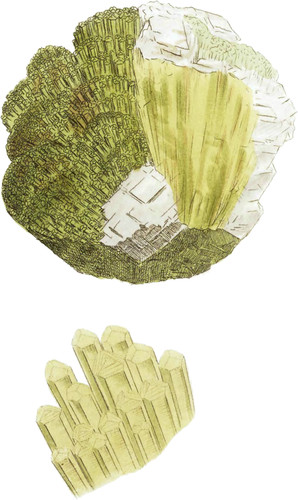 Enlarge
Enlarge
British Mineralogy
Carbnate of Strontia
- Class 2. Earths.
- Order 1. Homogeneous.
- Gen. 5. Strontia.
- Spec. 1. Carbonate.
- Div. 1. Crystallized.
- Gen. Char. Soluble in 200 parts of whater at a temperature of 60°. Separates from a saturated solution in nitric acid, in the form of rhomboidal crystals. Promotes the fusibility of most other earths. Most of its salts tinge flame red.
- Spec. Char. Combined with carbonic acid.
- Syn.
- Strontian earth combined with fixed air. Kirwan, v. 1. 332.
- Strontian carbonaté. Haüy, v. 2. 327.
This curious mineral was found some time since at Strontian in Scotland, in a lead mine which is now given up, as it would not answer to the purpose of the proprieters; but seems not to have been suspected to contain a new earth until Dr. Craufurd sent it to Mr. Kirwan in 1790. It was afterwards examined by Dr. Hope and others. We do not know that it has been found any where else. Its crystals are confusedly grouped, more or less diverging from a centre. They sometimes show the appearance of a six-sided prism, as Haüy has observed.
The specimen figured was sent me by my friend Mr. Sims of Norwich. It has 6-sided prisms, terminated at one end with three faces, resembling those of carbonate of lime, with the obtuse æquiaxe termination. We have a specimen with six-sided bars quite relieved crossing an hollow: three faces of the prism are generally broader than the other three, showing faint longitudinal straiæ and fractures parallel to them; but most reaily to the three broader faces with transverse striæ, which continue to the apex of the pyramid, and occasionally form an equilateral triangle. The pyramid may be divided ina direction contrary to its faces; therefore the nucleus is a dodecaëdron with rhomboidal faces.
They vary in colour from a brightish watery green to a palish brown. It differs from carbonate of barytes (with which it was confounded), by its weight, as well as by dissolving quickly, and with great effervescence, in nitric acid, without leaving a precipitate: and it is curious that a bit of paper or a wick of a candle, dipped in this solution, after being dried, causes the flame to burn beautifully red; or the substance itself in fusion by the blowpipe will do the same thing. Spec. Grav. from 3.4–3.675. Hardness 5, according to Kirwan. Scratches carbonate of lime, and is scratched by fluate of lime.
Analysis by Pelletier:
| Strontia | 62 |
| Carbonic acid | 30 |
| Water | 8 |
| 100 |
It is accompanied by carbonate of lime, sulphuret of barytes, sulphuret of lead, and harmotome of Haüy, or staurolite of Kirwan.

